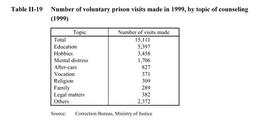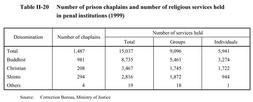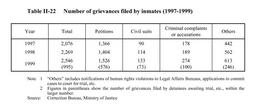| Previous Next Index Image Index Year Selection | |
|
|
3 Priority of treatment in the central period (1)Classification surveys
In the central period(that is, the time between the end of the initial guidance and training and the beginning of pre-release guidance), classification surveys are carried out in order to decide classification grades and cell allocation, determine treatment guidelines, implement transfers, and assist in the screening of applications for progression and parole. These are repeated about every two months for inmates serving terms of less than 8 months and about twice a year for other inmates, either on a regular basis or on an ad hoc basis whenever necessary. (2)Prison work a Overview Prison work is one of the priority treatments designed to aid the reform and social rehabilitation of inmates. Among others, its purpose is to nurture inmates'willingness to work, teach them occupational knowhow and skills, and foster the qualities of patience and concentration. The forms of prison work are divided, according to their nature and purpose, into manufacturing work, occupational training, and self-sustenance of the institution. The latter includes work needed for the self-sustaining operations of the institution, including cooking, laundry, and cleaning(clerical work), and work needed for direct labor such as maintenance of the institution(building&maintenance work). There are 7 sectors of manufacturing work, including woodwork, printing, tailoring, and metalwork. I nmates are allocated to work designated under their respective trades, in accordance with their individual aptitudes. Prison work is mainly carried out by inmates sentenced to imprisonment with labor and detainees in work houses, who are obliged to perform the requisite work under the Penal Code. But some voluntary work is also undertaken by inmates sentenced to imprisonment without labor, detainees awaiting trial, and others who are not legally obliged to work. The proportion of inmates engaged in voluntary work as of March 31st, 2000 was 93.7% of inmates sentenced to imprisonment without labor and 0.3% of detainees awaiting trial. The average daily workforce engaged in prison work in fiscal 1999 (accounting year)was around 43,000, and the revenue from prison work was around 10.3 billion yen. Meanwhile, in 1983 a system for providing the raw materials necessary for prison work and buying the resultant products was introduced by CAPIC(the Correctional Association Prison Industry Cooperation), in line with the principles of reform of the national treasury administration. The manufactured products are exhibited and traded under the CAPIC brand at correction exhibitions all over the country, notably at the National Correction Exhibition held in Tokyo in the first part of June every year. b Working conditions The working hours of working inmates are 8 hours per day and 40 hours per week, with Saturdays and Sundays off, as a rule. The inmates are allowed breaks during their working hours. In these and other ways, steps are taken to enhance the working environment and labor health and safety, in line with the principles of the Labor Standards Law, the Industrial Safety and Health Law, and others. Inmates are also paid compensation(sickness, injury, and death benefits)in the event of unforeseen accidents during their work. All revenue from prison work reverts to the state. However, a work remuneration is paid to those engaged in the work. The work remuneration has the nature of benevolence or encouragement, rather than a wage as payment for labor, and, in principle, is paid upon release. The average monthly work remuneration per inmate in fiscal 1999 (accounting year) was 4,082 yen. Meanwhile, under certain conditions, inmates are also allowed to engage in work that provides them with a source of income in their spare time(inmates'"side jobs"). As of March 31st, 2000, 150 inmates were engaged in such work, yielding an average monthly income of 5,561 yen per person. In correctional institutions, external work is also carried out. This includes work managed by the prison itself, and other work undertaken in ordinary businesses with the cooperation of private sector companies. Working formats include"residential work", for which inmates are accommodated at the work site, and"commuting work"for which inmates travel to the work site from the correctional institution. The nature of the work is mainly agricultural or livestock farming, woodwork, metalwork, or shipbuilding. c Occupational training Occupational training is designed to teach inmates the skills needed for their occupation, or to improve their skills. It takes three forms, namely general training, group training, and internal training. Efforts are made to help inmates obtain official qualifications or licenses as much as possible. General training is given in 7 designated general occupational training facilities(Fukui, Yamaguchi, and Yamagata Prisons, and Kawagoe, Nara, Saga, and Hakodate Juvenile Prisons), for which eligible participants are selected from all over the country. For group training, various training topics are decided in each Regional Correction Headquarters, and in each institution for internal training. In fiscal 1999 (accounting year), there were 28 institutions giving group training and 45 giving internal training. Occupational training is given on 54 topics, including sheet metalwork, welding, electrical engineering, car maintenance, construction, plastering, carpentry, platemaking/printing, woodcraft, boiler operation, construction machinery, hairdressing, coiffure, cleaning, car driving, nursing services, and small construction machinery. In fiscal 1999 (accounting year), 1, 762 inmates completed training, while a total of 2,178 inmates obtained qualifications or licenses as welding technicians, electrical engineers, boiler operators, and so on. (3)Educational activities Educational activities in correctional institutions consist, among others, of academic education, correspondance courses, and life guidance. They are implemented both inside and outside the institutions and play a major role in attempting to rehabilitate inmates and encourage their return to society. Table II-18 shows the state of implementation of outside education activities over the last3years. Table II-18 Outside education activities (1997-1999) a Academic educationFor academic education, revision and reinforcement lessons in Japanese language, mathematics, history, and other basic subjects are given to inmates who have not completed compulsory education, or who have low academic ability despite completing compulsory education. At Matsumoto Juvenile Prison, in particular, a branch of the local junior high school has been set up, and lessons are given to groups of eligible inmates who have not completed compulsory education. In March 2000, certificates of graduation were given to 11 of these course graduates. Meanwhile, at the Matsumoto, Nara, and Morioka Juvenile Prisons, senior high school courses in communication systems are given with the cooperation of the local prefectural senior high schools, while at the Kawagoe Juvenile Prison and several other prisons, inmates wishing to enter university are given guidance on university entrance exams, and steps are taken to help them sit the exams. During 1999, a total of 5,369 inmates attended academic education lessons. Of these, 290 had not completed compulsory education, 3,542 had completed only compulsory education, 773 had dropped out of senior high school, and 711 had graduated from senior high school. b Correspondance courses Correspondance courses are given with a view to improving inmates'general education as well as their occupational knowhow, skills, and so on. Course students are divided into those receiving public finance, for whom the state covers all costs needed for the tuition, and self-financing students, who cover the costs themselves. During fiscal 1999 (accounting year) there were 2,822 students in all, studying topics such as bookkeeping, calligraphy, penmanship, English, radio and electrics, and other subjects. c Life guidance Life guidance is designed to appeal to the self-awareness of inmates, cultivate correct living habits and work ethics, and nurture attitudes, habits, knowledge, and others for leading communal life. As well as discipline training, lectures, reading guidance, club activities, various meetings, and so on, counseling is also given both individually and in groups. d Guidance depending on type of treatment In guidance depending on type of treatment, attention is focussed on the factors that lead to criminal behavior as well as the offenses themselves. Inmates belonging to the same types are grouped together and given effective guidance, and guidance aimed at preventing stimulant drug abuse is given in nearly all institutions. Apart from this, guidance is also given on individual problems such as withdrawal from gang organizations(boryokudan), education on alcohol abuse, and traffic safety guidance. (4)Voluntary prison visits and religious services a Voluntary prison visits Voluntary prison visits are given by members of voluntary prison visit committees, organizations of private sector volunteers who give advice and guidance to individual inmates regarding their anxieties, families, jobs, future life plans, and other problems. These visits are now firmly established as an important means of treatment whereby these problems may be solved. Voluntary prison visitors are qualified or experienced individuals, religious persons, persons connected with rehabilitation and probation, and others, who are recommended by the wardens of correctional institutions and commissioned by the Superintendents of Regional Correction Headquarters. They serve for two years, but may be re-appointed. As of December 31st, 1999, there were 1,192 voluntary prison visitors, who can be broken down, by particular area of specialization, into 218 in literary arts, 214 in education, 156 in religion, 152 in rehabilitation and probation, 84 in law, 69 in trade and commerce, and 47 in social welfare, among others. Table II-19 shows the number of voluntary prison visits made in 1999, by counseling topics. Meanwhile, to enhance voluntary prison visit activities, the National Federation of Voluntary Visit Committees has been set up as a nationwide organization of such committees. Table II-19 Number of voluntary prison visits made in 1999, by topic of counseling (1999) b Religious servicesReligious services are given by religious volunteers from the private sector("prison chaplains")to fill the religious needs of inmates with religious beliefs, those who seek a religion, and those who have an interest in religion, and to guarantee their religious freedom. Religious services are designed to help inmates cultivate their faith in accordance with the doctrine of their preferred religion, and to foster morality as well as aiming for their emotional stability, thereby making them better prepared for rehabilitation. Table II-20 shows the number of prison chaplains as of December 31st, 1999, and the number of religious services held in 1999. Table II-20 Number of prison chaplains and number of religious services held in penal institutions(1999) The National Federation of Prison Chaplains exists as a national organization for chaplains.(5)Food, clothing, daily requisites, etc. Inmates are provided with the necessary food and drink, taking account of their physical condition, health, age, work, and other factors. They are also lent or supplied clothes, bedding, daily requisites, and others necessary for daily life. For food, staple meals are divided into types A, B,and C depending on the occupation, with different calorie counts for men and women. Since April 1st, 2000, A meals have provided 1,600 kcal per day for men and 1,400 kcal for women, B meals 1,300 kcal per day for men and 1,200 kcal for women, and C meals 1,200 kcal per day for men and 1,100 kcal for women. For example, an adult male engaged in standing work in a factory would be given A meals, with 2,620 kcal per day including side dishes. The daily cost of side dishes in fiscal 2000 (accounting year)is 434.02 yen per adult inmate. Meanwhile, special consideration is given to meals for the infirm, pregnant women, and inmates engaged in physically taxing labor. The content of meals is also altered for inmates with special requirements due to religious considerations or pronounced differences in diet. As for clothes and bedding, consideration is particularly paid to heat insulation, hygiene, fitting, etc. , while inmates are allowed to purchase some daily requisites at their own expense or bring them in from the outside. (6)Medical treatment and hygiene Medical departments or sections are set up in correctional institutions in accordance with their scale and the nature of their operation. Doctors and other medical specialists are appointed to these, and are engaged in work related to medical treatment and hygiene in the institution. Some correctional institutions, namely Hachioji, Okazaki, and Jono Medical Prisons and Osaka Medical Branch Prison, specialize in medical treatment, while 6 others around the country(Fuchu, Nagoya, Hiroshima, Fukuoka, Miyagi, and Sapporo Prisons)have been designated as medical priority institutions. Medical equipment and staff are intensively allocated in these. As of April 1st, 2000, the specialist medical staff capacity of correctional institutions consisted of 226 doctors, 35 pharmacists, 18 nutritionists, 20 radiologists, 16 clinical hygiene inspectors, and 252 nurses(male and female). (7)Security The security of correctional institutions(the function of maintaining the safety and orderliness of institutions)forms a foundation upon which the treatment of inmates can be smoothly implemented. Table II-21 shows the state of incidence of"prison accidents", including escapes, homicide, and injury, over the last 3 years. Table II-21 Number of accidents occurring in penal institutions (1997-1999) Inmates who break the rules of correctional institutions are penalized. In 1999, penalties for such violations were imposed on inmates in 26,416 cases. Of the rules broken, assault on other inmates (15.6%), neglect of work duty (13.5%), and fighting (9.8%) accounted for the highest proportions.(8)System of grievances When inmates have complaints against the actions of an institution, they can file them as civil suits or administrative litigation, criminal complaints or accusations, notifications of human rights violations, and so on, under normal procedures. But in addition to these, they may also file petitions to the Minister of Justice or his inspectors(Justice Ministry officers who make on-the-spot inspections of correctional institutions under orders from the Minister of Justice)as a system under existing prison legislation. Finally, they may also request hearings from the warden of the institution in question(warden hearings). Petitions are sent to the Minister in writing, or may be submitted to an inspector either in writing or orally. In either case, confidentiality is protected to ensure that the staff of the institution cannot know the content of the complaint in advance. Table II-22 shows the number of grievances filed over the last 3 years. Table II-22 Number of grievances filed by inmates (1997-1999) |




